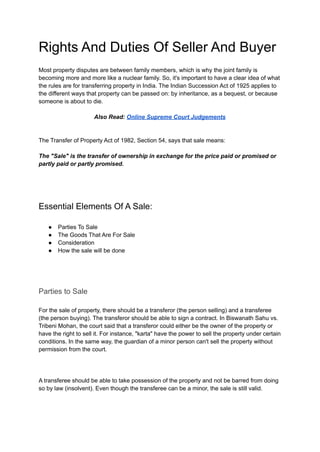
Rights And Duties Of Seller And Buyer.pdf
- 1. Rights And Duties Of Seller And Buyer Most property disputes are between family members, which is why the joint family is becoming more and more like a nuclear family. So, it's important to have a clear idea of what the rules are for transferring property in India. The Indian Succession Act of 1925 applies to the different ways that property can be passed on: by inheritance, as a bequest, or because someone is about to die. Also Read: Online Supreme Court Judgements The Transfer of Property Act of 1982, Section 54, says that sale means: The "Sale" is the transfer of ownership in exchange for the price paid or promised or partly paid or partly promised. Essential Elements Of A Sale: ● Parties To Sale ● The Goods That Are For Sale ● Consideration ● How the sale will be done Parties to Sale For the sale of property, there should be a transferor (the person selling) and a transferee (the person buying). The transferor should be able to sign a contract. In Biswanath Sahu vs. Tribeni Mohan, the court said that a transferor could either be the owner of the property or have the right to sell it. For instance, "karta" have the power to sell the property under certain conditions. In the same way, the guardian of a minor person can't sell the property without permission from the court. A transferee should be able to take possession of the property and not be barred from doing so by law (insolvent). Even though the transferee can be a minor, the sale is still valid.
- 2. The Goods That Are For Sale The sale of property given by this act only applies to property that can't be moved. This type of property can be tangible (something you can touch and feel) or intangible (a right of easement). Also, the owner made a clear statement that he was giving his right to the property to the transferee, who can be easily found. Consideration For a sale to be valid, there must be money in exchange for ownership. Nothing else can be used as a valid exchange for ownership. Time has nothing to do with the consideration, which means that money can be paid before, at, or after the sale is made. How the sale will be done For a sale deed to be valid, the transferor must put it in writing, it must be properly attested, and it must be registered. However, these requirements are not necessary for properties with a nominal value or a value of less than 100 rupees. In contrast, a simple transfer of property can be used to sell property worth less than 100 rupees. In Meghan Enterprises Private Limited v. Official Liquidator, the court said that the above three things are not needed for the sale of the property being auctioned by the court, and that the certificate of sale by the court is all that is needed for that sale. The agreement to sell A contract of sale is only a legal agreement about an immovable property if the parties agree on the terms for selling the property. It doesn't give anyone the right to own or charge the property. It's just a piece of paper that gives more information about the sale of deed.
- 3. But the sale of contract gives the transferee some rights because, after the sale of contract, the transferor can't sell the property to anyone else, and the transferee can sue the transferor for the same reason. What Makes a Sale Different from a Contract of Sale: When an immovable property is sold under the TPA, the owner of the property changes. A contract for the sale of real estate is just an agreement that the property will be sold in the future on terms that both parties agree on. A right in rem is made when a TPA is sold. A right in personam is created by a contract to sell. Rights and Duties of the Buyer and the Seller: Unless they have a contract that says otherwise, the buyer and seller of immovable property have the rights and responsibilities listed in the rules that follow (or those that apply to the property sold). The seller must do the following: Tell the buyer about any major flaws in the property or the seller's right to sell it that the seller knows about but the buyer doesn't and that the buyer couldn't find with normal care. Tell the buyer about any major flaws in the property or the seller's right to sell it that the seller knows about but the buyer doesn't; When asked, the seller must give the buyer all title papers for the property that are in his possession or under his control. Must answer, to the best of his knowledge, any questions the buyer has about the property or the title to it; Execute a valid conveyance of the property when the buyer gives it to him at the right time and place after paying or offering to pay the amount due for the price;
- 4. To take as good care of the property and any title papers related to it while he has them between the date of the contract of sale and the day the property is given to the buyer as a prudent owner would. Conclusion When someone buys a piece of property, they take on all the rights and responsibilities that come with it. But a contract of sale only shows that someone is willing to sell the property. A sale is when the property is actually sold. The idea of property is at the center of civil law. The Civil Procedure Code and the Transfer of Property Act tell how it should be done. Both lawyers and the general public need to know the details of how property is bought and sold.